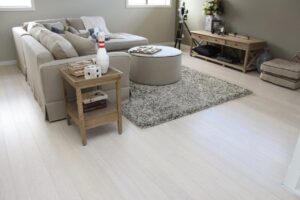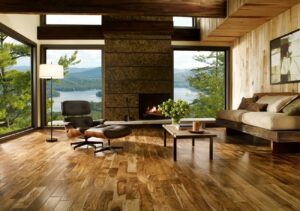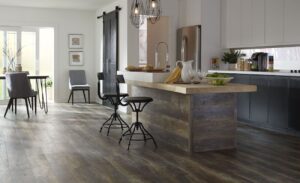Have you ever thought about having hardwood flooring in the kitchen? This can be a dilemma since not all flooring types are created the same.
Hardwood is one of the toughest and strongest types of flooring that is super popular among homeowners and builders.
Not only it is durable and sturdy, but it can significantly add an artistic and aesthetic value to the property. But then, it isn’t 100% perfect.
It can’t stand water because the nature of wood is to absorb and soak water. That’s why water would be the floor’s number one nemesis.
If you want to install hardwood in the living room or the home office, it won’t be a problem.
Unfortunately, kitchen isn’t exactly a dry spot. It is known as sporadically humid or semi-wet area that is prone to spills and splashes.
Of course, the kitchen isn’t as wet or as humid as the bathroom, but still… there is always a possibility that a great deal of spills and splashes would take place in the kitchen.
There is an ongoing controversy about hardwood flooring in the kitchen where some people believe that it’s okay, while the others have the opposite opinion.
Well, having the hardwood floor isn’t impossible for the kitchen setting, but then again, you may have to do some extra work for it.
So, let’s dig deeper into the matter and know some of the basic facts.
Kitchen Hardwood Flooring Pros
Having hardwood flooring in the kitchen has its own perks, and you can enjoy tons of positive outcome from it.
For a starter, wood floor has its own natural appeal. It creates warm and inviting feel not to mention it has its own strong homey vibe.
If you like to hang out in the kitchen or you use it as the main place to entertain guests and friends (instead of the living room), then you will make it inviting and timeless with the wood floor.
Attractive surface and outlook is one major appeal that you will love about the hardwood floor on the kitchen.
Second, wooden floor is beautiful. It is simple and direct, and yet it exudes elegance and timeless effect.
Not many homeowners realize that wooden floor can affect the value of the property. And hardwood will definitely affect the value, considering the toughness and durability.
Read Also: Porcelanosa Wood Like Tile Reviews
If you are thinking about increasing the value of your house, then you should seriously think about having hardwood floor.
Another benefit to like about the hardwood floor is the fact that you can refinish it. If it turns dull and it has lost its shine (which is common after a few years), you can always refinish it.
It may take extra work, but to make the shine returns, it is worth to try. In fact, you can refinish it several times until it reaches its end of the life-cycle.
Fourth, hardwood floor is warm and soft especially when compared to tile.
If you live in the area where it is cool or when it can be chilly at some times, having hardwood floor is more suitable.
When you use tiles in the kitchen, it may not be the best idea especially if you have to stand for quite a while.
Tiles are hard on the feet those tiles will make your feet sore and tired. But that won’t be the case with wood.
Hardwood floor is warm and it can be quite ideal for cold and chilly areas.
Kitchen Hardwood Flooring Downsides
Despite all the great benefits offered by hardwood flooring in the kitchen, be prepared of some possible downsides.
After all, the flooring isn’t perfect so downsides and flaws should be expected.
- High Cost
Hardwood floor is tough, solid, and sturdy. But the quality has made it one of the priciest materials ever existed in home improvement industry.
If you want to install hardwood floor, you will have to spend quite a lot and not all homeowners have the budgets.
Keep in mind that not only you will have to spend a lot of money for the materials, but you must think about the high installation cost too.
For some homeowners, this can be too much.
- Difficult DIY
You probably think that you can manage all the installation work on your own to save up money.
However, it isn’t advisable to do it on your own unless you have the skills and the expertise. Installing hardwood floor isn’t exactly an easy DIY project.
Well, you can do it on your own but be ready with the risks usually involving messy results and difficult process.
- Complicated and Difficult Maintenance
Installing hardwood flooring in the kitchen is possible but you should be ready with the extra maintenance.
You will have to seal the floor to strengthen the water repellent feature. You will have to do regular check.
You will have to re-apply the seal once in every year or once in several years. Wipe all the spills right away. Don’t let water pooling happens.
Will you be able to do these things?
- Sensitive Floor
Floor is tough, but the surface is prone to dents, scratches, and water damage. If there is water spill that you don’t remove right away, it will stain the surface.
If you place heavy furniture on the floor, it may dent or scratch the floor. If you like wearing high heels, you will definitely scratch the floor.
The Cost
Be ready to spend around $5 to $10 for a square foot of standard hardwood like cherry, maple, and oak. If you want tropical hardwood, such as Brazilian walnut or mahogany), it costs around $8 to $14.
If you choose the engineered type, it ranges between $3 and $13 a square foot. Professional installation may take you between $3 and $8 a square foot.
The Installation
The process depends on the type of the floor itself. Planks generally use mill with locking edges using tongue and groove mechanism. Boards are generally glued down.
Engineered type may use the click-and-lock system. The unfinished floor may still require staining, sanding, and sealing, while the prefinished type doesn’t.
You can immediately use the latter one right after the installation.
Unfinished vs Prefinished Floor
Before you decide having hardwood flooring in the kitchen, there are several considerations that you need to make. The floor isn’t for everyone and every space.
You will have to consider your personal requirements, the layout of the house, and lifestyle.
Nowadays, most homeowners would turn to the prefinished type because of its simplicity and easiness.
Since you won’t have to stain, sand, and finish the floor after the installation, the prefinished floor is considered more efficient.
You only need to nail it down and it is good to go!
However, prefinished floor have a tad beveled edge, which is responsible for the finished appearance. But the bevel itself can act as the entrance for spills.
The bevels would create tiny gap or track (between boards) where spills can run down. If you do want to have the prefinished type, you need to seal the bevel and crack.
If you don’t mind the extra work, the unfinished floor would be more ideal for kitchen setting. Yes, you will have to stain, sand, and seal the floor.
Not only it takes extra work, but it also takes extra time too. But if you can do it, you can create a smooth and uniformed surface.
Once you seal the gap and crack, your floor would hold up just fine.
Read Also: LifeProof Wood Look Tile Flooring Review
The Extra Efforts
The longevity of the hardwood flooring in the kitchen depends on your cleaning routine.
After all, care and maintenance are crucial they can determine the quality of your floor as well as how long it would hold up the ‘abuse’.
These things may seem simple but they can be quite handy to prolong the life-cycle of the hardwood floor.
- When there are spills, wipe them off right away. Never let them sit. You want to make sure that the surface remains dry all the time
- Steam floor cleaner may damage the floor’s finish so it is advisable not to use it
- You can use soft cloth or cotton dust mop to perform the cleaning. Using a broom is okay, but make sure that you use the one with soft rubber-y bristles so the surface won’t be scratched
- If you have to move heavy appliances or pieces of furniture (such as the fridge, stove, or dishwasher), use the thin plywood sheet. Place it on your floor and then slide the pieces on it. Don’t slide them on the wood floor it will scratch and damage the surface, for sure.
- For high traffic areas, consider using mats or rugs. Not only they will protect the floor, but they will also absorb spills so the liquid won’t make a direct contact with the floor
- It is advisable to use furniture pads on chairs and tables. In this way, they won’t scratch or dent the floor
- Check the area around your dishwasher and under the sink regularly. Also check the area around the fridge. You should search for any leaking sign. If there is one, shut the water off and contact a plumber right away.
All in all, you won’t know whether the hardwood floor would be the ideal pick for you and your house until you have an honest review about yourself and your lifestyle.
Having hardwood flooring in the kitchen is possible but only if your personal space allows it and you don’t mind with the extra efforts.





